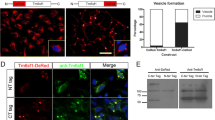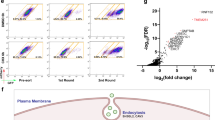Abstract
In the previous proteomic study of human placenta, transmembrane 7 superfamily member 1 (TM7SF1) was found enriched in lysosome compartments. TM7SF1 encodes a 399-amino acid protein with a calculated molecular mass of 45 kDa. Bioinformatic analysis of its amino acid sequence showed that it is a multipass transmembrane protein containing a potential dileucine-based lysosomal targeting signal and four putative N-glycosylation sites. By percoll-gradient centrifugation and further subfraction ways, the lysosomal solute and membrane compartments were isolated respectively. Immunoblotting analysis indicated that TM7SF1 was co-fractioned with lysosome associated membrane protein 2 (LAMP2), which was only detected in lysosomal membrane compartments whereas not detected in the solute compartments. Using specific anti-TM7SF1 antibody and double-immunofluorescence with lysosome membrane protein LAMP1 and Lyso-Tracker Red, the colocalisations of endogenous TM7SF1 with lysosome and late endosome markers were demonstrated. All of this indicated that TM7SF1 is an integral lysosome membrane protein. Rat ortholog of TM7SF1 was found to be strongly expressed in heart, liver, kidney and brain while not or low detected in other tissues. In summary, TM7SF1 was a lysosomal integral membrane protein that shows tissue-specific expression. As a G-protein-coupled receptor in lysosome membrane, TM7SF1 was predicted function as signal transduction across lysosome membrane.





Similar content being viewed by others
References
Saftig P, Klumperman J (2009) Lysosome biogenesis and lysosomal membrane proteins: trafficking meets function. Nat Rev 10(9):623–635
Ballabio A, Gieselmann V (2009) Lysosomal disorders: from storage to cellular damage. Biochim Biophys Acta 1793(4):684–696
Luzio JP, Pryor PR, Bright NA (2007) Lysosomes: fusion and function. Nat Rev 8(8):622–632
Divangahi M, Chen M, Gan H, Desjardins D, Hickman TT, Lee DM, Fortune S, Behar SM, Remold HG (2009) Mycobacterium tuberculosis evades macrophage defenses by inhibiting plasma membrane repair. Nat Immunol 10(8):899–906
Coxon FP, Taylor A (2008) Vesicular trafficking in osteoclasts. Semin Cell Dev Biol 19(5):424–433
Callahan JW, Bagshaw RD, Mahuran DJ (2009) The integral membrane of lysosomes: its proteins and their roles in disease. J proteomics 72(1):23–33
Schroder B, Wrocklage C, Pan C, Jager R, Kosters B, Schafer H, Elsasser HP, Mann M, Hasilik A (2007) Integral and associated lysosomal membrane proteins. Traffic (Copenhagen, Denmark) 8(12):1676–1686
Lubke T, Lobel P, Sleat DE (2009) Proteomics of the lysosome. Biochim Biophys Acta 1793(4):625–635
Zhang H, Fan X, Bagshaw RD, Zhang L, Mahuran DJ, Callahan JW (2007) Lysosomal membranes from beige mice contain higher than normal levels of endoplasmic reticulum proteins. J Proteome Res 6(1):240–249
Schieweck O, Damme M, Schroder B, Hasilik A, Schmidt B, Lubke T (2009) NCU-G1 is a highly glycosylated integral membrane protein of the lysosome. Biochem J 422(1):83–90
Jialin G, Xuefan G, Huiwen Z (2010) SID1 transmembrane family, member 2 (Sidt2): a novel lysosomal membrane protein. Biochem Biophys Res Commun 402(4):588–594
Schroder B, Wrocklage C, Hasilik A, Saftig P (2011) Molecular characterisation of ‘transmembrane protein 192’ (TMEM192), a novel protein of the lysosomal membrane. Biol Chem 391(6):695–704
Zhang H, Fan X, Bagshaw R, Mahuran DJ, Callahan JW (2008) Purification and proteomic analysis of lysosomal integral membrane proteins. Methods Mol Biol (Clifton, NJ 432:229–241
Braulke T, Bonifacino JS (2009) Sorting of lysosomal proteins. Biochim Biophys Acta 1793(4):605–614
Liu T, Qian WJ, Gritsenko MA, Camp DG 2nd, Monroe ME, Moore RJ, Smith RD (2005) Human plasma N-glycoproteome analysis by immunoaffinity subtraction, hydrazide chemistry, and mass spectrometry. J Proteome Res 4(6):2070–2080
Spangenberg C, Winterpacht A, Zabel BU, Lobbert RW (1998) Cloning and characterization of a novel gene (TM7SF1) encoding a putative seven-pass transmembrane protein that is upregulated during kidney development. Genomics 48(2):178–185
Futai E, Yagishita S, Ishiura S (2009) Nicastrin is dispensable for gamma-secretase protease activity in the presence of specific presenilin mutations. J Biol Chem 284(19):13013–13022
Millar RP, Newton CL (2010) The year in G protein-coupled receptor research. Mol Endocrinol (Baltimore, MD) 24(1):261–274
Acknowledgments
This work was partially supported by Talents Foundation of Yijishan Hospital (YR201104).
Author information
Authors and Affiliations
Corresponding authors
Rights and permissions
About this article
Cite this article
Gao, J., Xia, L., Lu, M. et al. TM7SF1 (GPR137B): a novel lysosome integral membrane protein. Mol Biol Rep 39, 8883–8889 (2012). https://doi.org/10.1007/s11033-012-1755-0
Received:
Accepted:
Published:
Issue Date:
DOI: https://doi.org/10.1007/s11033-012-1755-0




